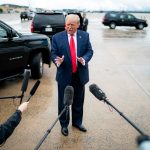President Donald Trump recently cranked up the trade war dial by slapping 25% tariffs on steel and aluminum imports, making it clear that the U.S. will no longer be a doormat for China’s economic antics. Following successful negotiations with Japan, Trump is rallying allies to create a more united front against the world’s manufacturing heavyweight, which has been gorging on strategic resources while the U.S. sat back and attempted to play nice.
China has dominated the market on essential commodities for far too long, hobbling American manufacturing potential. In a bold display of American ingenuity, Trump announced that Nippon Steel would be investing in U.S. Steel—an alternative to the outright takeover that was the plan before he took charge. Pinching the Japanese firm’s wallet rather than handing over the keys is a clear win, and one more example of how Trump intends to turn the tide back in favor of American workers.
The Trade Wars Begin as Trump slaps tariffs on Mexico, Canada, and China.
It'll hit them much harder than it hits us.
But there's an off-ramp if these countries can control illegals and fentanyl.
As for inflation, everything now depends on Congress slashing federal spending. pic.twitter.com/qJLxZuCwgg
— Peter St Onge, Ph.D. (@profstonge) February 3, 2025
As Trump so eloquently put it—if they raise their tariffs, we raise ours. It’s a simple concept that seems to be lost on many other world leaders, who have preferred the complacency of the status quo. Economic advisers have already catalyzed conservative thought, insisting that Trump’s approach could create waves throughout global trade. With the U.S. having the lowest tariffs of major economies, it is high time for other countries to reevaluate their tariff-heavy strategies—or continue to face the consequences of American retaliation.
Trump’s strategy extends beyond just trade with Japan. The President is also looking at his neighbors to the north and south, Canada and Mexico, seeking the best method to reshape North American trade relations. Having previously negotiated a comprehensive agreement, Trump is now pushing for tighter borders and mutual support in combating issues like illegal trafficking. That includes a pause on tariffs—giving those countries a level of breathing room to meet America half way.
When it comes to China, Trump’s resolve is firmer than ever. An agreement with Japanese Prime Minister Shigeru Ishiba to tackle Chinese economic aggression showcased an understanding that both countries have skin in this game. Concerns about Beijing’s ambitions in places like Taiwan align with U.S. interests, making for a natural coalition against a common adversary. The narrative emerging from some backbench political journalists might lead the masses to believe that Americans fear economic fallout from tariffs, but representatives show little concern from their constituents. Voter support is grounded in the belief that these tariffs are not just a necessary evil; they are a strategic maneuver meant to regain some much-needed American economic independence.
Despite alarm bells ringing from analysts projecting doom and gloom, markets seemed unusually calm in the face of these bold moves. Americans understand that a little turbulence now could mean a more stable economic future later, as the country shifts from play-pretend diplomacy to serious economic strategy. In a game where only the most robust survive, Trump’s approach isn’t just refreshing—it’s downright necessary.




